University Economics Assignment: Elasticity and International Trade
VerifiedAdded on 2020/04/15
|8
|864
|413
Homework Assignment
AI Summary
This economics homework assignment explores two key areas: price elasticity of demand and international trade theories. The first part analyzes price elasticity, differentiating between elastic and inelastic demand and its implications for firms, particularly monopolists and oligopolistic firms. It examines how firms like Woolworths and Coles in Australia utilize price elasticity in their pricing strategies. The second part delves into international trade theories, contrasting absolute and comparative advantages. It explains how comparative advantage, based on opportunity cost, influences trade patterns, and discusses how countries like China make decisions regarding specialization in labor-intensive versus capital-intensive goods, considering factors like future labor wage increases. The assignment includes references to academic sources supporting the analysis.
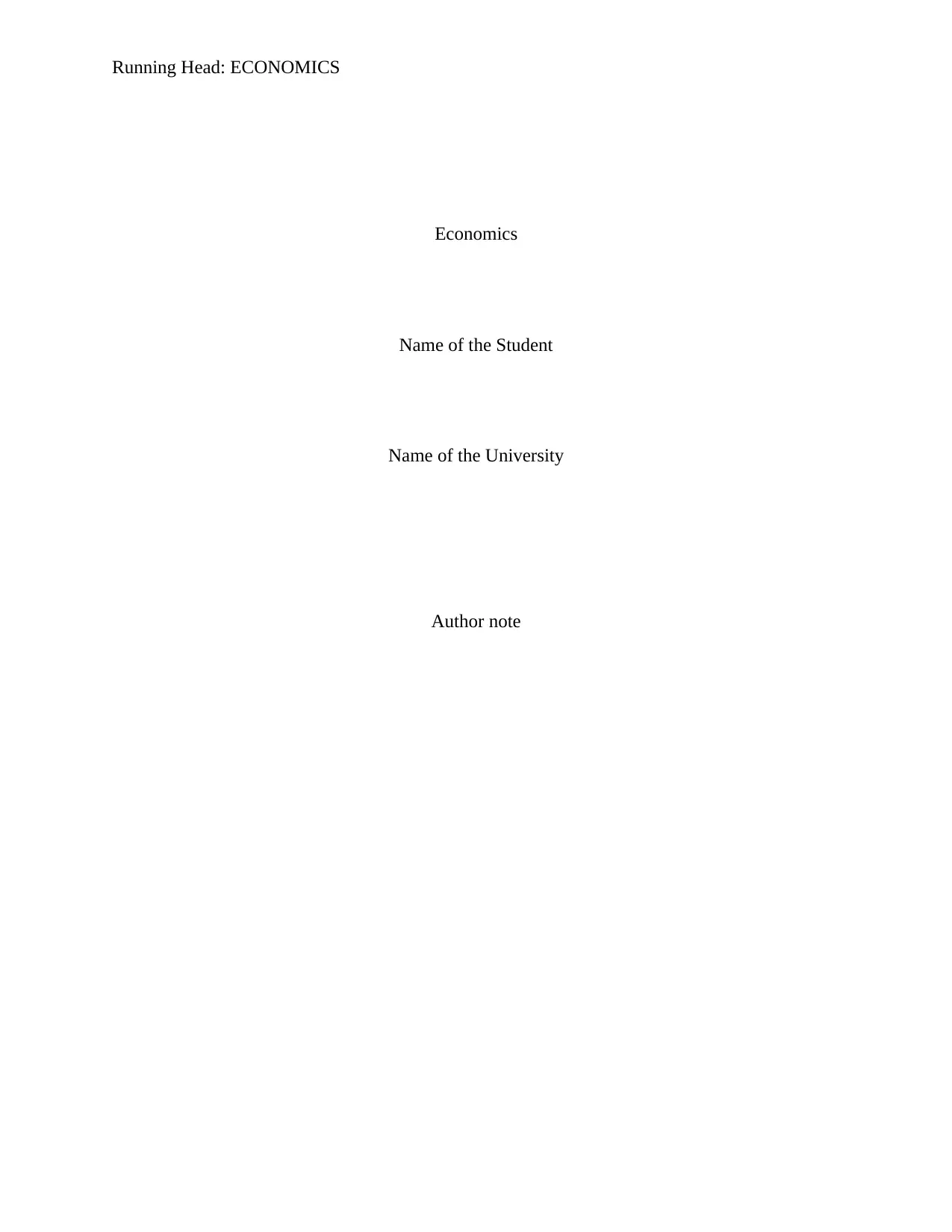
Running Head: ECONOMICS
Economics
Name of the Student
Name of the University
Author note
Economics
Name of the Student
Name of the University
Author note
Paraphrase This Document
Need a fresh take? Get an instant paraphrase of this document with our AI Paraphraser
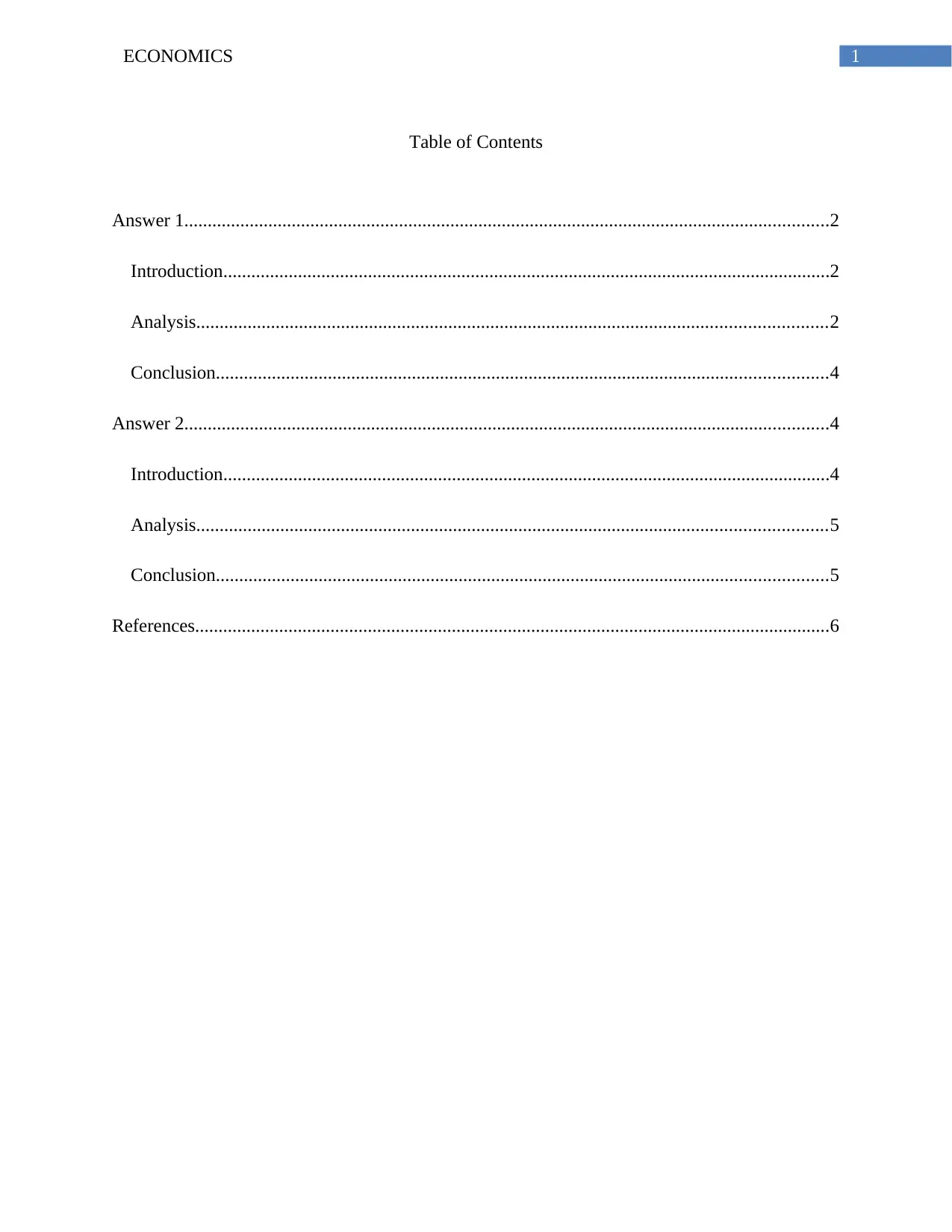
1ECONOMICS
Table of Contents
Answer 1..........................................................................................................................................2
Introduction..................................................................................................................................2
Analysis.......................................................................................................................................2
Conclusion...................................................................................................................................4
Answer 2..........................................................................................................................................4
Introduction..................................................................................................................................4
Analysis.......................................................................................................................................5
Conclusion...................................................................................................................................5
References........................................................................................................................................6
Table of Contents
Answer 1..........................................................................................................................................2
Introduction..................................................................................................................................2
Analysis.......................................................................................................................................2
Conclusion...................................................................................................................................4
Answer 2..........................................................................................................................................4
Introduction..................................................................................................................................4
Analysis.......................................................................................................................................5
Conclusion...................................................................................................................................5
References........................................................................................................................................6
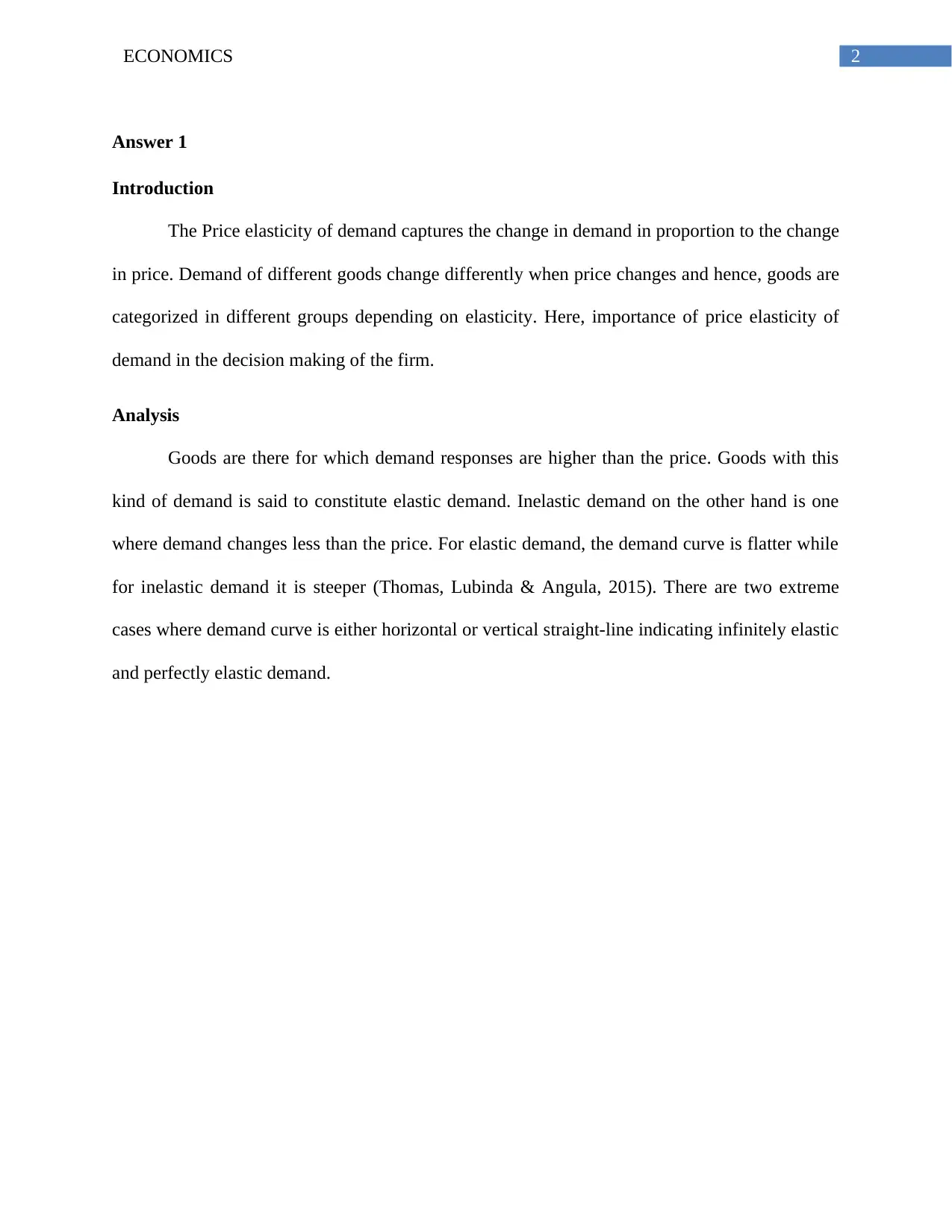
2ECONOMICS
Answer 1
Introduction
The Price elasticity of demand captures the change in demand in proportion to the change
in price. Demand of different goods change differently when price changes and hence, goods are
categorized in different groups depending on elasticity. Here, importance of price elasticity of
demand in the decision making of the firm.
Analysis
Goods are there for which demand responses are higher than the price. Goods with this
kind of demand is said to constitute elastic demand. Inelastic demand on the other hand is one
where demand changes less than the price. For elastic demand, the demand curve is flatter while
for inelastic demand it is steeper (Thomas, Lubinda & Angula, 2015). There are two extreme
cases where demand curve is either horizontal or vertical straight-line indicating infinitely elastic
and perfectly elastic demand.
Answer 1
Introduction
The Price elasticity of demand captures the change in demand in proportion to the change
in price. Demand of different goods change differently when price changes and hence, goods are
categorized in different groups depending on elasticity. Here, importance of price elasticity of
demand in the decision making of the firm.
Analysis
Goods are there for which demand responses are higher than the price. Goods with this
kind of demand is said to constitute elastic demand. Inelastic demand on the other hand is one
where demand changes less than the price. For elastic demand, the demand curve is flatter while
for inelastic demand it is steeper (Thomas, Lubinda & Angula, 2015). There are two extreme
cases where demand curve is either horizontal or vertical straight-line indicating infinitely elastic
and perfectly elastic demand.
⊘ This is a preview!⊘
Do you want full access?
Subscribe today to unlock all pages.

Trusted by 1+ million students worldwide
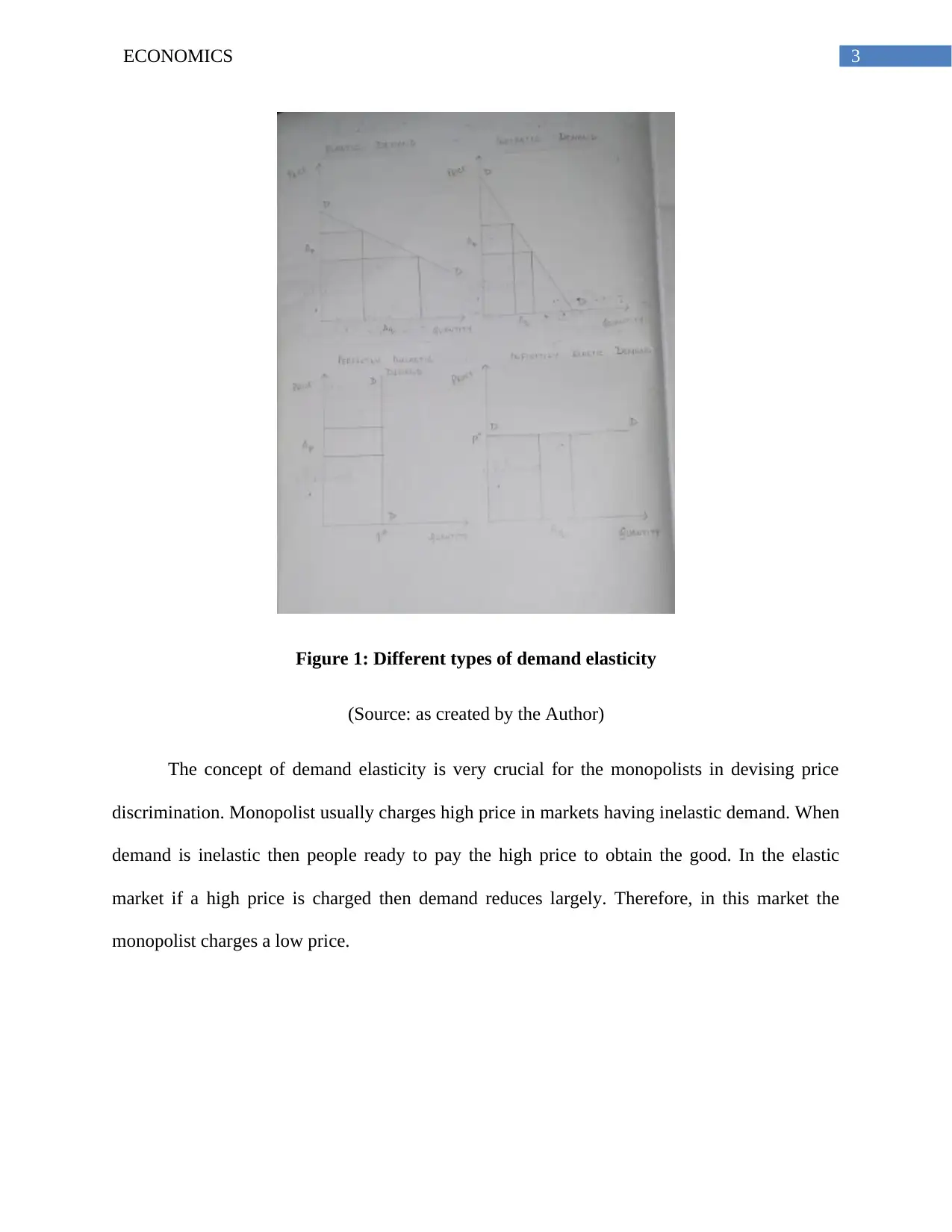
3ECONOMICS
Figure 1: Different types of demand elasticity
(Source: as created by the Author)
The concept of demand elasticity is very crucial for the monopolists in devising price
discrimination. Monopolist usually charges high price in markets having inelastic demand. When
demand is inelastic then people ready to pay the high price to obtain the good. In the elastic
market if a high price is charged then demand reduces largely. Therefore, in this market the
monopolist charges a low price.
Figure 1: Different types of demand elasticity
(Source: as created by the Author)
The concept of demand elasticity is very crucial for the monopolists in devising price
discrimination. Monopolist usually charges high price in markets having inelastic demand. When
demand is inelastic then people ready to pay the high price to obtain the good. In the elastic
market if a high price is charged then demand reduces largely. Therefore, in this market the
monopolist charges a low price.
Paraphrase This Document
Need a fresh take? Get an instant paraphrase of this document with our AI Paraphraser
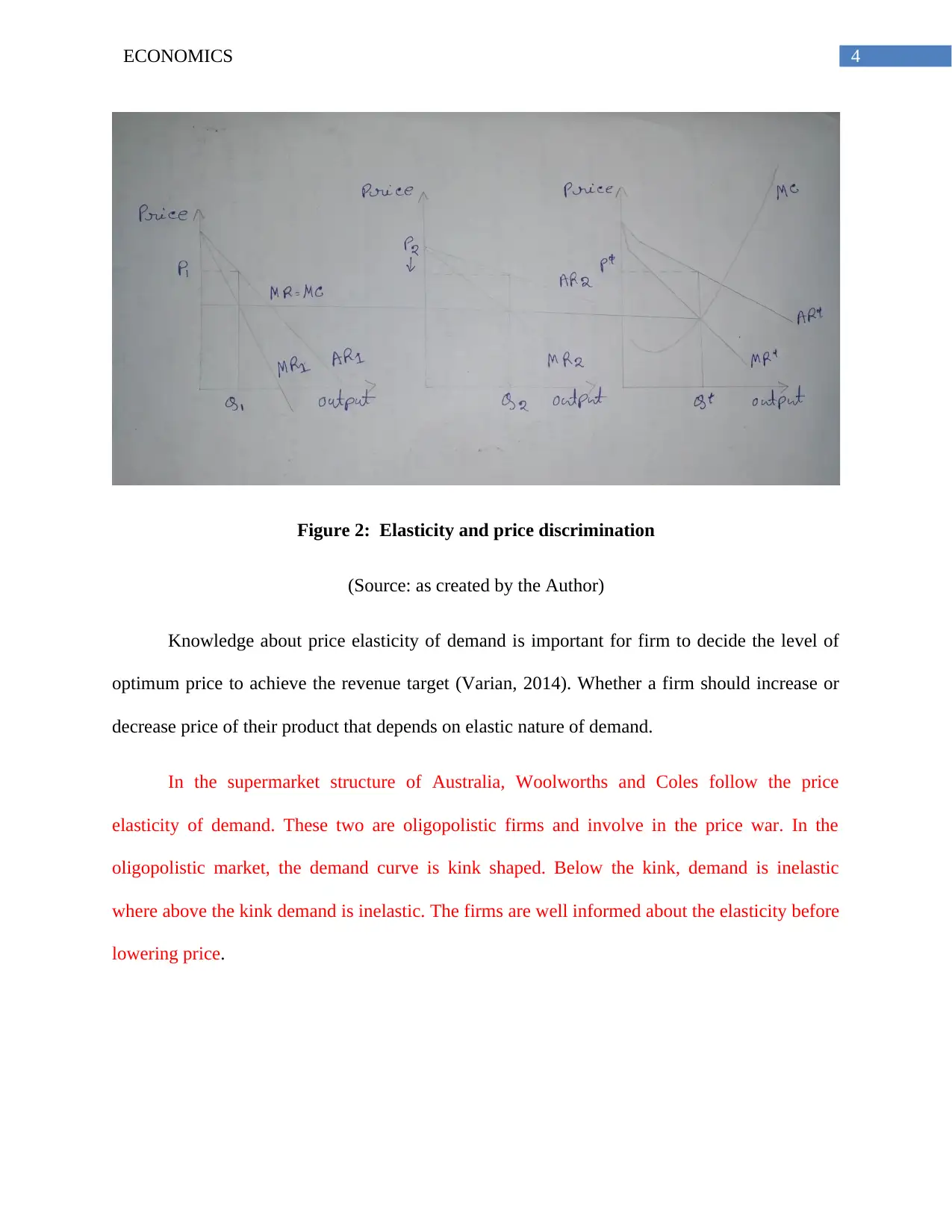
4ECONOMICS
Figure 2: Elasticity and price discrimination
(Source: as created by the Author)
Knowledge about price elasticity of demand is important for firm to decide the level of
optimum price to achieve the revenue target (Varian, 2014). Whether a firm should increase or
decrease price of their product that depends on elastic nature of demand.
In the supermarket structure of Australia, Woolworths and Coles follow the price
elasticity of demand. These two are oligopolistic firms and involve in the price war. In the
oligopolistic market, the demand curve is kink shaped. Below the kink, demand is inelastic
where above the kink demand is inelastic. The firms are well informed about the elasticity before
lowering price.
Figure 2: Elasticity and price discrimination
(Source: as created by the Author)
Knowledge about price elasticity of demand is important for firm to decide the level of
optimum price to achieve the revenue target (Varian, 2014). Whether a firm should increase or
decrease price of their product that depends on elastic nature of demand.
In the supermarket structure of Australia, Woolworths and Coles follow the price
elasticity of demand. These two are oligopolistic firms and involve in the price war. In the
oligopolistic market, the demand curve is kink shaped. Below the kink, demand is inelastic
where above the kink demand is inelastic. The firms are well informed about the elasticity before
lowering price.
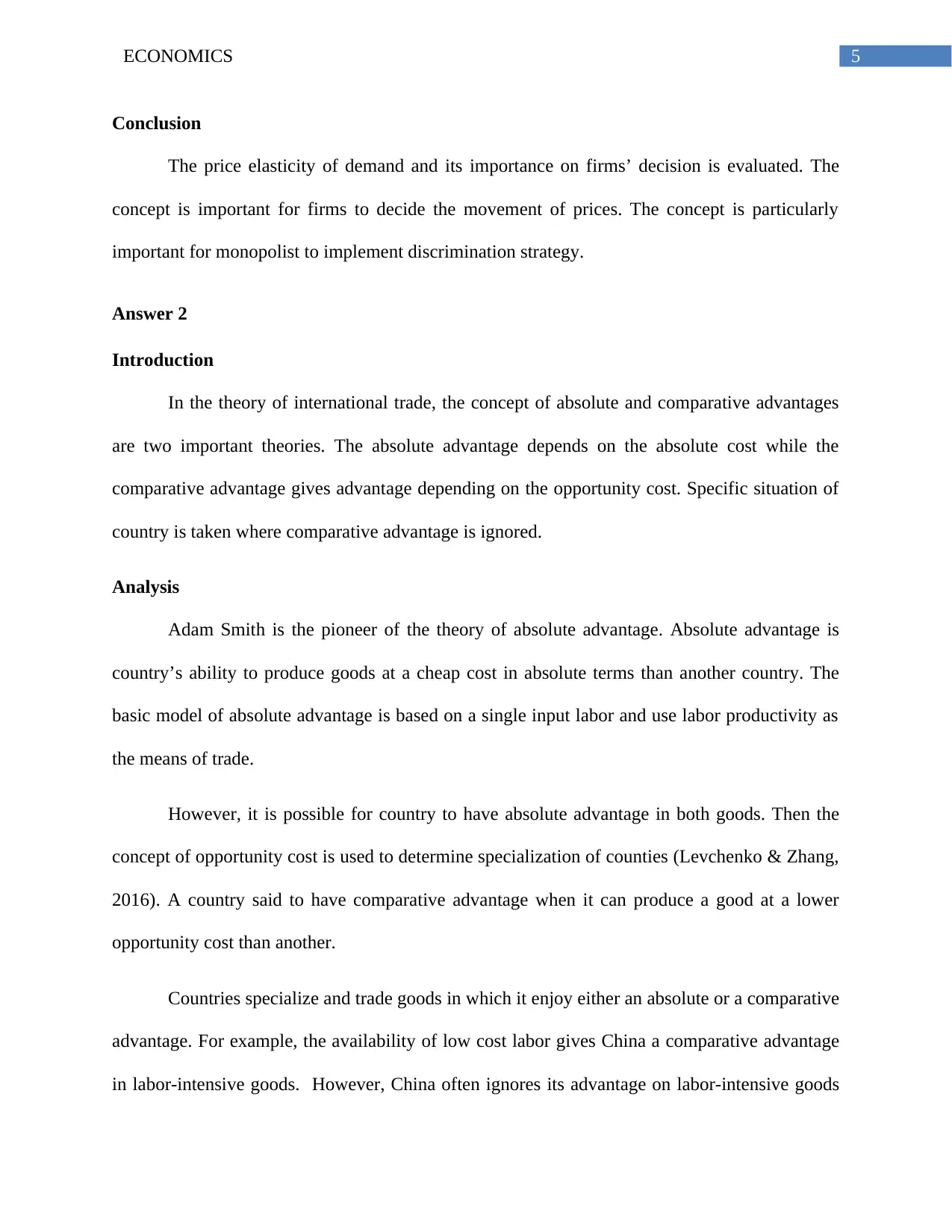
5ECONOMICS
Conclusion
The price elasticity of demand and its importance on firms’ decision is evaluated. The
concept is important for firms to decide the movement of prices. The concept is particularly
important for monopolist to implement discrimination strategy.
Answer 2
Introduction
In the theory of international trade, the concept of absolute and comparative advantages
are two important theories. The absolute advantage depends on the absolute cost while the
comparative advantage gives advantage depending on the opportunity cost. Specific situation of
country is taken where comparative advantage is ignored.
Analysis
Adam Smith is the pioneer of the theory of absolute advantage. Absolute advantage is
country’s ability to produce goods at a cheap cost in absolute terms than another country. The
basic model of absolute advantage is based on a single input labor and use labor productivity as
the means of trade.
However, it is possible for country to have absolute advantage in both goods. Then the
concept of opportunity cost is used to determine specialization of counties (Levchenko & Zhang,
2016). A country said to have comparative advantage when it can produce a good at a lower
opportunity cost than another.
Countries specialize and trade goods in which it enjoy either an absolute or a comparative
advantage. For example, the availability of low cost labor gives China a comparative advantage
in labor-intensive goods. However, China often ignores its advantage on labor-intensive goods
Conclusion
The price elasticity of demand and its importance on firms’ decision is evaluated. The
concept is important for firms to decide the movement of prices. The concept is particularly
important for monopolist to implement discrimination strategy.
Answer 2
Introduction
In the theory of international trade, the concept of absolute and comparative advantages
are two important theories. The absolute advantage depends on the absolute cost while the
comparative advantage gives advantage depending on the opportunity cost. Specific situation of
country is taken where comparative advantage is ignored.
Analysis
Adam Smith is the pioneer of the theory of absolute advantage. Absolute advantage is
country’s ability to produce goods at a cheap cost in absolute terms than another country. The
basic model of absolute advantage is based on a single input labor and use labor productivity as
the means of trade.
However, it is possible for country to have absolute advantage in both goods. Then the
concept of opportunity cost is used to determine specialization of counties (Levchenko & Zhang,
2016). A country said to have comparative advantage when it can produce a good at a lower
opportunity cost than another.
Countries specialize and trade goods in which it enjoy either an absolute or a comparative
advantage. For example, the availability of low cost labor gives China a comparative advantage
in labor-intensive goods. However, China often ignores its advantage on labor-intensive goods
⊘ This is a preview!⊘
Do you want full access?
Subscribe today to unlock all pages.

Trusted by 1+ million students worldwide
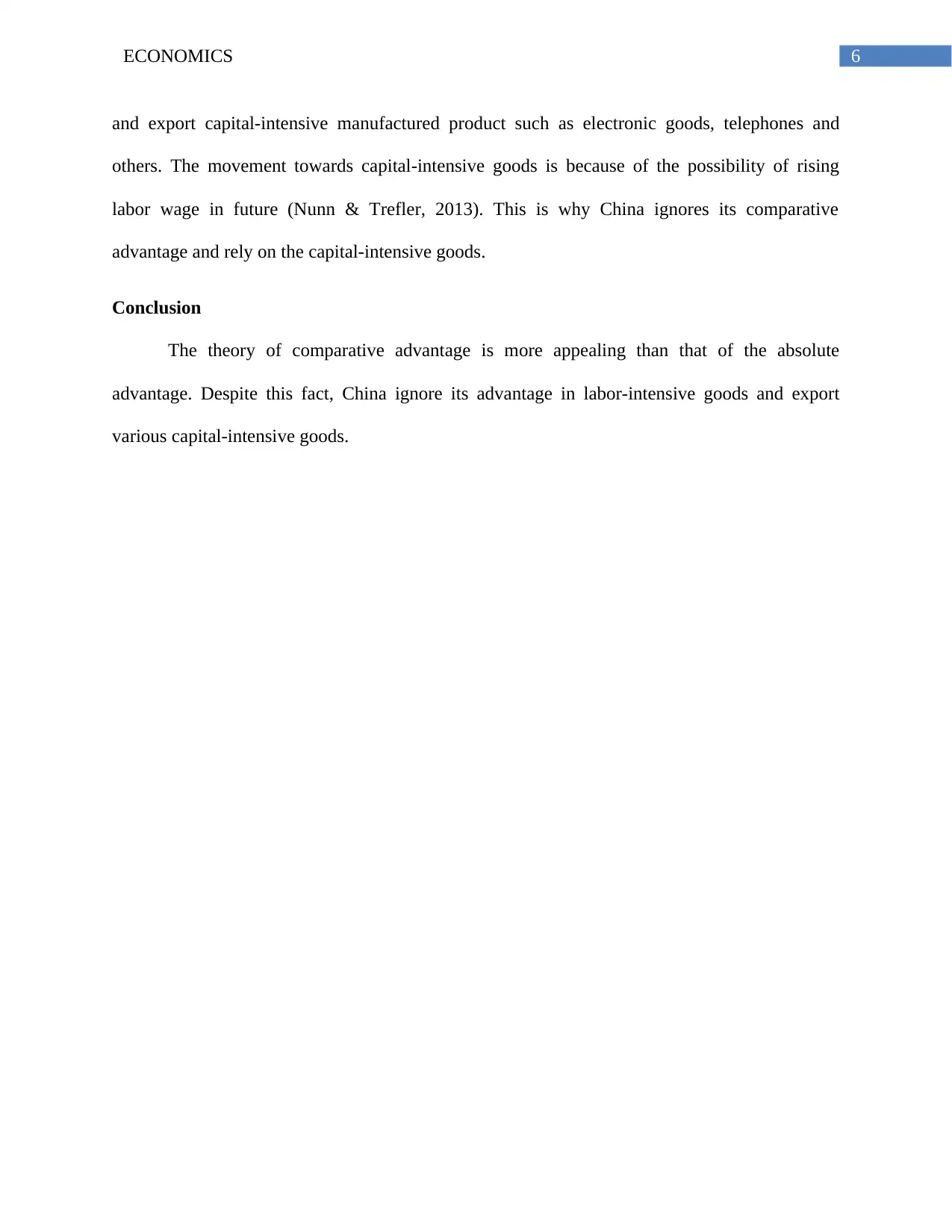
6ECONOMICS
and export capital-intensive manufactured product such as electronic goods, telephones and
others. The movement towards capital-intensive goods is because of the possibility of rising
labor wage in future (Nunn & Trefler, 2013). This is why China ignores its comparative
advantage and rely on the capital-intensive goods.
Conclusion
The theory of comparative advantage is more appealing than that of the absolute
advantage. Despite this fact, China ignore its advantage in labor-intensive goods and export
various capital-intensive goods.
and export capital-intensive manufactured product such as electronic goods, telephones and
others. The movement towards capital-intensive goods is because of the possibility of rising
labor wage in future (Nunn & Trefler, 2013). This is why China ignores its comparative
advantage and rely on the capital-intensive goods.
Conclusion
The theory of comparative advantage is more appealing than that of the absolute
advantage. Despite this fact, China ignore its advantage in labor-intensive goods and export
various capital-intensive goods.
Paraphrase This Document
Need a fresh take? Get an instant paraphrase of this document with our AI Paraphraser
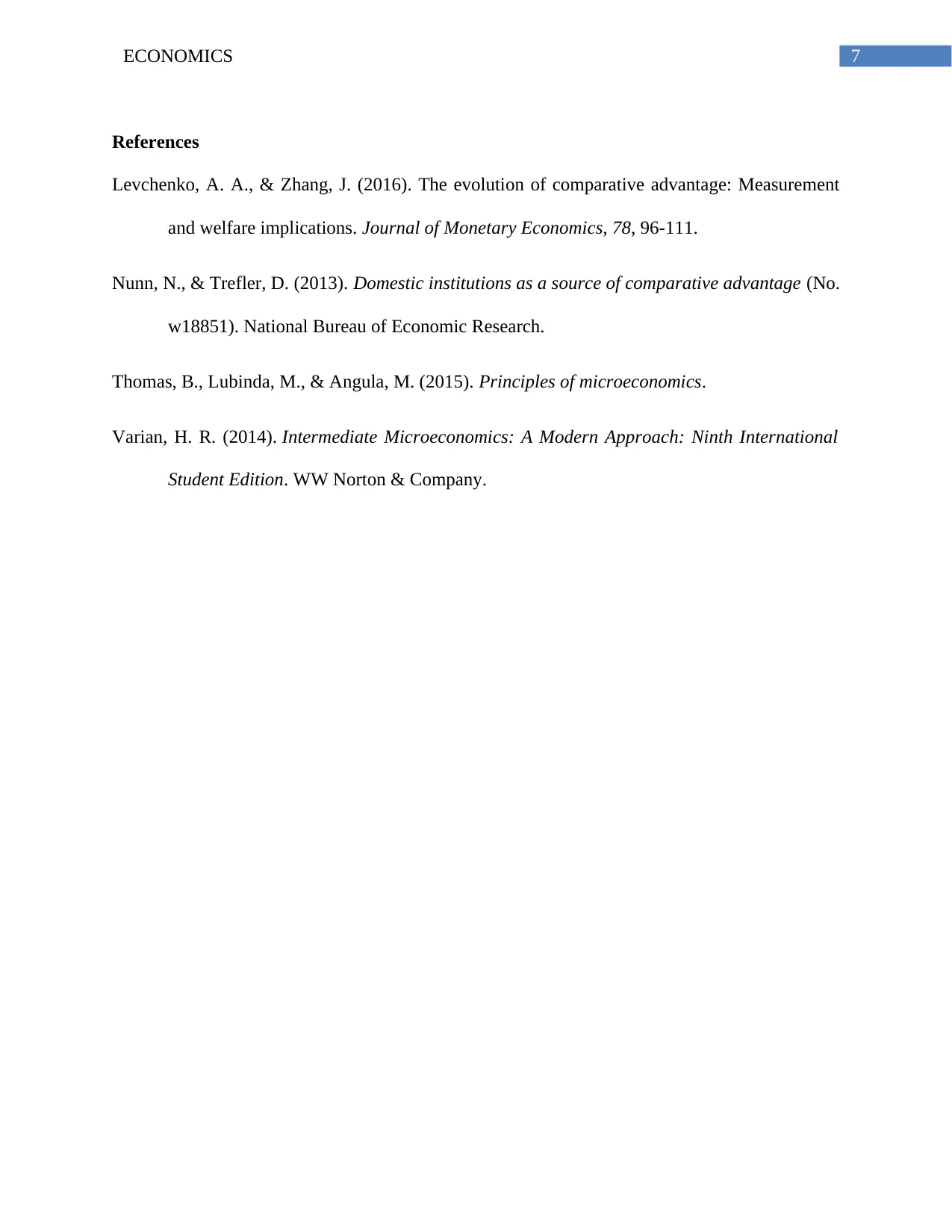
7ECONOMICS
References
Levchenko, A. A., & Zhang, J. (2016). The evolution of comparative advantage: Measurement
and welfare implications. Journal of Monetary Economics, 78, 96-111.
Nunn, N., & Trefler, D. (2013). Domestic institutions as a source of comparative advantage (No.
w18851). National Bureau of Economic Research.
Thomas, B., Lubinda, M., & Angula, M. (2015). Principles of microeconomics.
Varian, H. R. (2014). Intermediate Microeconomics: A Modern Approach: Ninth International
Student Edition. WW Norton & Company.
References
Levchenko, A. A., & Zhang, J. (2016). The evolution of comparative advantage: Measurement
and welfare implications. Journal of Monetary Economics, 78, 96-111.
Nunn, N., & Trefler, D. (2013). Domestic institutions as a source of comparative advantage (No.
w18851). National Bureau of Economic Research.
Thomas, B., Lubinda, M., & Angula, M. (2015). Principles of microeconomics.
Varian, H. R. (2014). Intermediate Microeconomics: A Modern Approach: Ninth International
Student Edition. WW Norton & Company.
1 out of 8
Related Documents
Your All-in-One AI-Powered Toolkit for Academic Success.
+13062052269
info@desklib.com
Available 24*7 on WhatsApp / Email
![[object Object]](/_next/static/media/star-bottom.7253800d.svg)
Unlock your academic potential
Copyright © 2020–2025 A2Z Services. All Rights Reserved. Developed and managed by ZUCOL.





